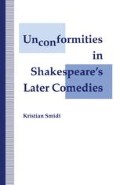Abstract
The difficulty of dealing with Pericles in a study of this kind hardly needs pointing out. Its structure, which is very much that of a travelogue, admits of incessant arrivals and departures which break up the plot, its shifting focus on different places and persons leaves little room for development of character, and its use of narrative, dumb shows and occasionally highly stylised dialogue gives an impression of technical randomness which defies ordinary standards of consistency. There is also a remarkable unevenness both as to phrasing and versification in the various parts of the play.1 Add to these internal qualities the uncertainty as to how much of the matter is Shakespeare’s, where his contributions begin and end and who else was behind the writing, and one may with good reason despair of any attempt to scrutinise the text systematically for unity and coherence. Pericles has attractions of its own for the theatre and perhaps particularly invites operatic treatment,2 but it is not a drama governed by the flexible order and submitting to the methodic restraints that we usually find in Shakespeare.
Access this chapter
Tax calculation will be finalised at checkout
Purchases are for personal use only
Preview
Unable to display preview. Download preview PDF.
Notes
See Frye, A Natural Perspective (1965), p. 28.
Wells and Taylor, William Shakespeare: A Textual Companion (1987), p. 557. Hoeniger accepts the majority view that ‘Shakespeare wrote most or all of Acts III–V’ and that ‘It is very doubtful whether [he] contributed anything to Acts I and II’, but he proposes a new candidate for co-authorship along with Wilkins: John Day (Arden Per., pp. lii–lxiii).
Hoeniger discusses Muir’s theory of an ‘Ur-Pericles’ (Muir, ‘The Problem of Pericles’, ES XXX, 1949, pp. 65–83, and elsewhere), see Arden Per., pp. xlvii–xlix.
Davies, ‘Pericles and the Sherley brothers’, in Honigmann (ed.), Shakespeare and His Contemporaries (1986), pp. 94–113, see esp. pp. 105–12.
White, Shakespeare and the Romance Ending (1981), p. 77.
Muir, Shakespeare’ Comic Sequence (1979), p. 155.
See Smidt, Unconformities in Shakespeare’s Tragedies (1989), p. 36.
Author information
Authors and Affiliations
Copyright information
© 1993 Kristian Smidt
About this chapter
Cite this chapter
Smidt, K. (1993). Fortune against Life-Force: The Pagan World of Pericles. In: Unconformities in Shakespeare’s Later Comedies. Palgrave Macmillan, London. https://doi.org/10.1007/978-1-349-13063-4_7
Download citation
DOI: https://doi.org/10.1007/978-1-349-13063-4_7
Publisher Name: Palgrave Macmillan, London
Print ISBN: 978-1-349-13065-8
Online ISBN: 978-1-349-13063-4
eBook Packages: Palgrave Literature & Performing Arts CollectionLiterature, Cultural and Media Studies (R0)

